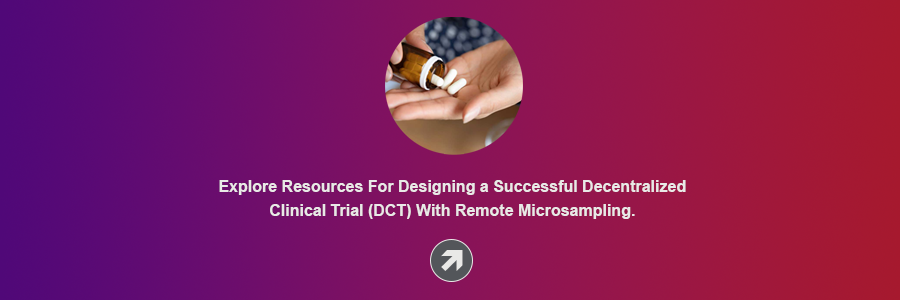Share this
clinical trials go remote with at home sample collection
by Neoteryx Microsampling on Mar 29, 2021 9:00:00 AM
 Clinical trials are vital to advancing medical science, but they face many stumbling blocks. New technology has given researchers the ability to take clinical trials outside the trial site and into the virtual space.
Clinical trials are vital to advancing medical science, but they face many stumbling blocks. New technology has given researchers the ability to take clinical trials outside the trial site and into the virtual space.
Recruiting study volunteers and following them during a clinical trial can often be done virtually, through telecommunications via email, online portals or chat rooms, and Zoom or other video-conferencing applications.
Remote specimen collection with microsampling uses portable tools like Mitra® devices and Mitra Sample Collection Kits that engage study participants in collecting their own specimen samples at home. This helps to simplify the clinical trial process and make it more convenient for study volunteers. They can help advance science from the comfort of home.
 Mitra devices with VAMS® technology is based on volumetric absorptive microsampling.
Mitra devices with VAMS® technology is based on volumetric absorptive microsampling.
This technology enables microsamples of blood or other biological fluids (urine, sweat, etc.) to be collected anytime, anywhere, and by anyone who can follow simple instructions.
/2022%20Mitra%20Lifestyle%20Images%20(approved)/mailing-no-cold-chain-Jul-07-2023-08-54-23-3311-PM.jpeg?width=381&height=241&name=mailing-no-cold-chain-Jul-07-2023-08-54-23-3311-PM.jpeg) The self-collected microsamples will dry on the device and can be mailed back to the lab via standard post.
The self-collected microsamples will dry on the device and can be mailed back to the lab via standard post.
In the lab, the microsamples will be analyzed following a workflow for dried blood spot (DBS) sample processing.
Published study results using remote microsampling provides accurate results that are comparable to those gathered from conventional sampling techniques performed onsite.
Remote microsampling also offers a unique opportunity for pharmaceutical companies and researchers to broaden access of clinical trials to a wider group of study volunteers, who would otherwise not be able to participate. Studies that involve volunteers who participate remotely across wider geographies and more diverse populations are now referred to as decentralized clinical trials.
Remote specimen collection also eliminates the need for trained phlebotomists and other professional staff to perform the blood collection for a decentralized clinical trial. This allows trials to be run at lower cost, with greater efficiency, and fewer constraints.
Expanding Access to Clinical Trials, Improving Enrollment
When potential study recruits are asked to visit a research center, hospital or clinic to participate in a clinical trial, it is likely they will only enroll in trials that are occurring close to their homes. Time and distance are barriers to onsite trial participation that can reduce the pool of potential candidates for a clinical study. These barriers can pose recruitment challenges for trial managers. This is especially true when a trial seeks participants with rare conditions that are harder to find in the local population.
Clinical trials also require participants who are willing to submit to regular medical testing and interviews over a long period of time. Many study participants abandon trials early because they find it difficult to visit the trial site multiple times in a week or month.
If study volunteers must absent themselves from work or school to attend appointments for the trial, the financial consequences are another factor that may discourage them from participating. Clinical trial participants may also avoid required blood collection visits because they fear needles, and any associated pain or discomfort.
Remote microsampling can help overcome these objections. Remote specimen collection with portable tools like the Mitra® device with VAMS® technology use a quick and nearly painless finger-stick method. They can be used anywhere. Researchers can ship Mitra devices and Mitra® Collection Kits to their trial recruits in any location.
Remote microsampling is minimally invasive and self-directed, and it eliminates phobia-inducing visits to a lab or clinic for a conventional blood draw. Remote approaches make sampling easier, more convenient, and more comfortable for participants. All of this makes them more likely to join and complete a trial to provide useful data for researchers.
Remote sampling is also useful for maintaining safe conditions in instances where disease transmission is a concern. Remote sampling with Mitra devices was used by the National Institutes of Health (NIH) to study the SARS-CoV-2 virus safely and effectively for a nationwide population study of undetected COVID-19 cases. Stanford Medicine at Stanford University also used Mitra devices to remotely study the effects of COVID-19 vaccines.
Remote Sampling Saves Time and Resources
There are many inefficiencies built into the traditional clinical trial process. Research staff members spend many hours each week coordinating onsite appointments, collecting samples, answering questions, and interviewing participants. This administrative work diverts resources away from more specialized and valuable work, such as data analysis.
Remote specimen collection eliminates many mundane and costly tasks, allowing researchers to focus on the work that leads to sharing and publishing their data to help improve public safety and clinical practice. It greatly reduces the administrative costs of an onsite clinical trial. In most cases, only standard lab equipment is needed to process and analyze remotely collected microsamples, so there is no need to acquire new equipment to transition to remote or decentralized clinical trials.
The physical space needed to house a traditional onsite clinical trial can be a stumbling block, so removing that challenge is a boon. Because onsite sample collection is no longer necessary with remote or decentralized approaches, institutions can often repurpose their trial sites for other uses, saving on facility costs as well.
Virtual Clinical Trials Offer Benefits
Decentralizing clinical trials can bring benefits to participants as well as researchers. These "virtual" trials give participants the opportunity to access cutting-edge treatments that may improve their conditions. By enrolling as a study participant, they may receive personalized medical care that would otherwise not be available to them. Participants may also find that access to an experimental treatment provides them with some relief of a health condition when no other medical intervention has worked.
Many clinical research participants genuinely hope to contribute to the development of new treatments and cures. In fact, this is often one of the main factors motivating patients to sign-up for clinical trials. Through their involvement, they hope to help and prevent others from suffering as they have suffered. Making it as easy as possible for participants to do this may help them commit to completing a trial as they also work on improving their health.
Taking Clinical Trials into the Future
Remote specimen collection using portable microsampling devices like the Mitra microsampler has the potential to revolutionize the way clinical trials are conducted, broadening horizons for both participants and researchers alike.
The time has come for drug development companies and the pharmaceutical industry to decentralize and virtualize clinical trials and begin reaping the benefits of the remote approach to sample collection.
Image Credits: Trajan, Neoteryx, Shutterstock
Share this
- Microsampling (206)
- Research, Remote Research (119)
- Venipuncture Alternative (105)
- Clinical Trials, Clinical Research (83)
- Mitra® Device (73)
- Therapeutic Drug Monitoring, TDM (51)
- Dried Blood Spot, DBS (39)
- Biomonitoring, Health, Wellness (30)
- Infectious Disease, Vaccines, COVID-19 (24)
- Blood Microsampling, Serology (23)
- Omics, Multi-Omics (21)
- Decentralized Clinical Trial (DCT) (20)
- Specimen Collection (18)
- Toxicology, Doping, Drug/Alcohol Monitoring, PEth (17)
- Skin Microsampling, Microbiopsy (14)
- hemaPEN® Device (13)
- Preclinical Research, Animal Studies (12)
- Pharmaceuticals, Drug Development (9)
- Harpera Device (7)
- Industry News, Microsampling News (5)
- Antibodies, MAbs (3)
- Company Press Release, Product Press Release (3)
- Environmental Toxins, Exposures (1)
- July 2025 (1)
- May 2025 (1)
- April 2025 (2)
- December 2024 (2)
- November 2024 (1)
- October 2024 (3)
- September 2024 (1)
- June 2024 (1)
- May 2024 (1)
- April 2024 (4)
- March 2024 (1)
- February 2024 (2)
- January 2024 (4)
- December 2023 (3)
- November 2023 (3)
- October 2023 (3)
- September 2023 (3)
- July 2023 (3)
- June 2023 (2)
- April 2023 (2)
- March 2023 (2)
- February 2023 (2)
- January 2023 (3)
- December 2022 (2)
- November 2022 (3)
- October 2022 (4)
- September 2022 (3)
- August 2022 (5)
- July 2022 (2)
- June 2022 (2)
- May 2022 (4)
- April 2022 (3)
- March 2022 (3)
- February 2022 (4)
- January 2022 (5)
- December 2021 (3)
- November 2021 (5)
- October 2021 (3)
- September 2021 (3)
- August 2021 (4)
- July 2021 (4)
- June 2021 (4)
- May 2021 (4)
- April 2021 (3)
- March 2021 (5)
- February 2021 (4)
- January 2021 (4)
- December 2020 (3)
- November 2020 (5)
- October 2020 (4)
- September 2020 (3)
- August 2020 (3)
- July 2020 (6)
- June 2020 (4)
- May 2020 (4)
- April 2020 (3)
- March 2020 (6)
- February 2020 (3)
- January 2020 (4)
- December 2019 (5)
- November 2019 (4)
- October 2019 (2)
- September 2019 (4)
- August 2019 (4)
- July 2019 (3)
- June 2019 (7)
- May 2019 (6)
- April 2019 (5)
- March 2019 (6)
- February 2019 (5)
- January 2019 (8)
- December 2018 (3)
- November 2018 (4)
- October 2018 (7)
- September 2018 (6)
- August 2018 (5)
- July 2018 (8)
- June 2018 (6)
- May 2018 (5)
- April 2018 (6)
- March 2018 (4)
- February 2018 (6)
- January 2018 (4)
- December 2017 (2)
- November 2017 (3)
- October 2017 (2)
- September 2017 (4)
- August 2017 (2)
- July 2017 (4)
- June 2017 (5)
- May 2017 (6)
- April 2017 (6)
- March 2017 (5)
- February 2017 (4)
- January 2017 (1)
- July 2016 (3)
- May 2016 (1)
- April 2016 (2)



Comments (1)